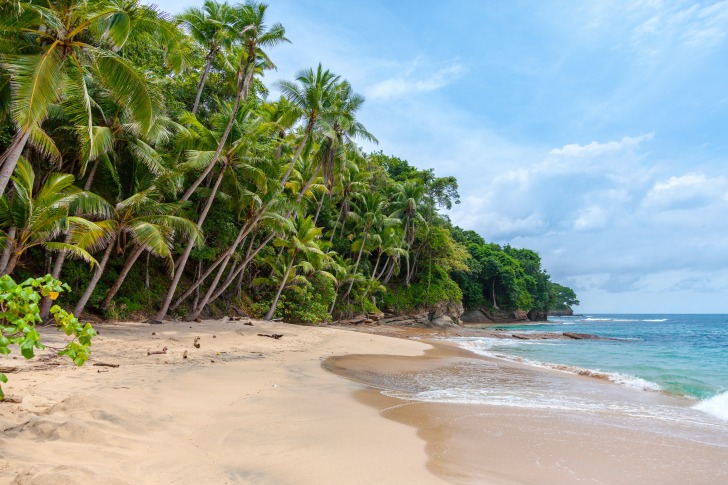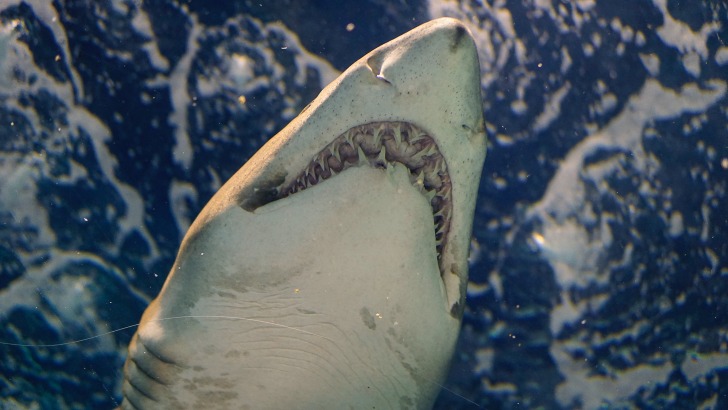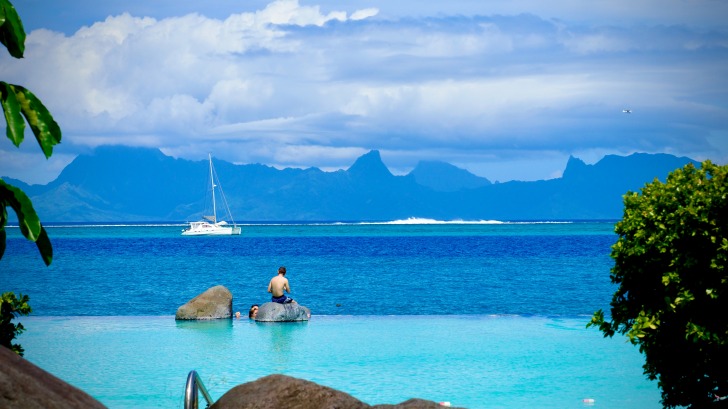I have heard of sharks all over Tahiti, the largest of the French Polynesia islands.
Is it true?
Let’s find out together.
Contents
So… Are There Sharks in Tahiti?
So far, I know that you can at least take a diving tour in Tahiti and swim with sharks.
If you do, you can see up to 19 different species of them.
You’ll also notice sharks near Bora Bora, Fakarava, Rangiroa, and Moorea.
Take advantage of the best times of the year to see sharks here based on two major regional locations and climates:
The Society Islands – Tahiti, Moorea, and Bora Bora make up this group of islands.
If you prefer to arrive during the cooler season, try between April and October.
It’s also drier during this time of year.
The Tuamotu Islands – Rangiroa and Fakarava make up this group of islands.
You could visit here year-round but may experience better visibility between November and March.
Some sharks show up about 50-80 feet from the shore.
Others may swim and live more offshore, at least 100 feet away.

This shark species list refers to some of the sharks that most often frequent Tahiti and the rest of French Polynesia.
At the same time, you’ll discover manta rays, sea turtles and bottlenose dolphins, or other creatures when snorkeling.
1. Blacktip Reef
One place you’ll find the blacktip reef shark spending its time north of Tahiti in Tetiaroa.
You’ll also find places to see them in Bora Bora if you want.
The Blacktip averages only about 5 feet lengthwise but can weigh about 280 pounds.
It sometimes swims in an “s” shape when feeling threatened.
It’s as if the Blacktip reef shark doesn’t know whether to take the “flight” or “fight” action.
This shark is known for its timidity, but it can also decide to defend itself by attacking you.
You don’t necessarily have to provoke it to get bit.
However, a perceived threat by you could aggravate a blacktip reef shark.
Don’t push your luck with this one.
2. Grey Reef
The Grey Reef shark swims around the Tuamotu Archipelago quite a bit.
La Vallee Blanche is another palace you may see this one.
The best way to understand this species’ behavior is to take a diving trip and witness it with your own eyes.
Both male and female grey reefs reach maturity at about 4-4.5 feet long.
They can grow to a maximum of about 8 feet though.
They may weigh as much as 74 pounds, which isn’t much for their length.
I imagine them as skinny little things.
Some pictures taken make them look plump though.
3. Lemon
Female lemon sharks like to take care of their young by giving birth to them inside the lagoons.
That’s where they can find the most food for themselves and hide from predators.
The waters that the mother stays in while nursing her pups are usually calm and shallow.
The lemon shark doesn’t always stay inside the lagoon though.
They often venture out inside and outside of it.
This species can live up to 30 years, grow from 8-10 feet, and weigh about 200 pounds as an adult.
Bora Bora is one place to find this one.
4. Great Hammerhead
The great hammerhead shark often roams the Tuamotu island group in French Polynesia.
It’s a protected species, an initiative brought forth in part by the Mokarran Protection Society.
This particular hammerhead species also shows up in Rangiora.
It often resides in one of the largest lagoons in the region.
The maximum weight is about 990 pounds, but the average number of pounds is about 510 pounds.
The average length is 11-15 feet, but they can grow to 20 feet.
5. Tiger
Apparently, Tahiti is one of the few places in the world where divers can meet up face-to-face with tiger sharks.
I’m not sure if I’d want to do that.
I have heard that the tiger shark is one of the most aggressive and responsible for the most human fatalities.
Other Tahiti Sharks
I’ve seen photos of other types of sharks that may show up in Tahiti and on other French Polynesia islands.
One is the silvertip shark, which can grow to about 6-8 feet and weigh a maximum of 358 pounds.
The maximum length is almost 10 feet, usually.
The Galapagos shark is another.
It grows to a maximum of 9.8 feet and weighs up to 430 pounds.
It may sometimes extend to 11.5 feet.
You might see this one at the Gambier atoll.
The Oceanic whitetip shark has sometimes made a presence in French Polynesia.
They typically grow to 10 feet but sometimes from 11-13 feet.
The maximum weight is about 370 pounds.
It’s periodically spotted on the Anaa atoll of the Tuamotu islands.
A Shark “Lookalike”
Another animal that some explorers might mistake for a shark is the barracuda.
Some species have teeth, jaws, snouts, eyes, and skin that looks like sharks.
Some of them, however, might have “bug eyes” or look like long fish, which is what it actually is — a fish.
Is it Safe to Swim in Tahiti?
Unless told otherwise, some places you can swim in Tahiti include Tereia, Matira, and Tautira Beaches.
Others include Temae or Far Beaches.
Keep in mind that could change, so keep up with current updates about where you can and cannot swim in Tahiti.
Even if sharks aren’t an issue in certain areas where you swim, water quality might be.
Every location has beach reports on file for that jurisdiction.
If you want to learn more about safe swimming, check out the World Health Organization Recreational Water Quality Guidelines.
If the water has been tested and reports indicate “not safe for swimming,” then it’s probably contaminated with bacteria.
Otherwise, watch out for tropical storms or high tide reports, or toxic waste dumps and oil spills.
You’ll know how to understand what the bacteria readings mean and what safe levels of water bacteria are for swimming or drinking.
Interesting Shark Facts In Tahiti
Some publishers have called Tahiti the “shark capital of the world.”
I don’t believe that totally.
After I did a bit of a check, I found out they might be mixing it up with New Smyrna Beach in Florida, which is sometimes called the “shark bite capital of the world.”
On the other hand, if I spent five more minutes researching what I found out about Florida, I’d probably find more conflicting information.
Sometimes, to be less confused, less bad research is best.
Anyway, this is what Tahiti is known for concerning sharks: In 2012, a significant “economic zone” in French Polynesia became a “shark sanctuary.”
That’s why at least 19 but a documented total of 20 sharks can reportedly “reign in peace” here.
When it comes to interacting with sharks in Tahiti and the other French Polynesia island groups, it’s not usually difficult.
Sometimes, they’re more afraid of people than we are of them.
The “no fishing” shark regulations seemed to have brought at least some harmony to this area.
Sharks usually like a comfortable temperature.
They’ll usually swim around until they find water that’s about 60-80 degrees.
That’s why you might see them in the early spring or just before winter.
Most of the sharks in French Polynesia prefer saltwater over freshwater.
In fact, most sharks never stay in freshwater any longer than necessary to grab food or perhaps cool off.
It’s sometimes cooler in the inland waters than on the ocean coast.

3 Safety Tips for Swimming in Shark-infested Waters
Tahiti and the rest of the French Polynesia island groups seem to have a handle on the shark situation.
One preliminary piece of advice is to stick with guided tours if you’re an inexperienced diver and use life preservers if you are not that good of a swimmer.
Then, follow these tips for swimming with sharks – in or out of an organized snorkeling tour.
1. Try not to scream.
That’s probably easier said than done if you enter waters not expecting a shark.
Either way, try not to scream, or you will startle the shark and raise your risk of getting attacked.
Along with not screaming, try not to show any signs of fear.
Don’t even think about being afraid and take a deep breath.
Just slowly walk out of the water without trying to recreate a Jaws movie scene.
Of course, intentionally seeing the sharks is a different story.
You put yourself in that situation on purpose.
For that, you should prepare yourself for handling sharks in advance.
2. Take diving classes.
If you take diving classes before you snorkel, it can ease you into learning how to integrate with sharks.
Remember, shark attacks are rare.
When you educate yourself before diving, you’re taking a calculated versus a blind risk, which is much safer.
3. Have an emergency plan.
If you’re diving with a group, you can all teach each other hand signals.
Then, you can use those agreed-upon signals to alert each other of danger.
Pay attention as well when taking guided tours.
They will show you warning signs of shark aggression.
Summary
Tahiti does have about 19-20 active shark species in it.
There are certain zones where they can freely live.
People also dive here with them.
They’re near most of the French Polynesia islands.
Tahiti Safety Overview
READ THE FULL REPORT: Tahiti Safety Review
Safety Index:
- OVERALL RISK: MEDIUM
- TRANSPORT & TAXIS RISK: MEDIUM
- PICKPOCKETS RISK: LOW
- NATURAL DISASTERS RISK: HIGH
- MUGGING RISK: LOW
- TERRORISM RISK: LOW
- SCAMS RISK: LOW
- WOMEN TRAVELERS RISK: HIGH
Frequently Asked Questions
How many people have died from Tahiti shark attacks?
Nobody has died in Tahiti of a shark attack in more than 50 years.
Only six confirmed shark attacks reportedly have occurred here since 1580 that no human had provoked.
Bites on humans are rare here, probably because they’re given their own area to live in.
Can I take children to view sharks?
Although not 100% foolproof, the best place to take children to see sharks is at aquariums.
The animals are confined, usually indoors.
It’s also the best way to view ocean life without actually swimming in the ocean.
Is shark hunting allowed in Tahiti?
You’re not allowed to fish for sharks (no hunting them) in Tahiti.
You also can’t sell any products you have derived from them.
For instance, you can’t produce tooth necklaces or earrings, or any product you’ve made from its skin for sale.











